The first time I looked into the rating scale on our website, I couldn’t help but wonder why we had to rate the difficulty level of our treks on a scale of 1 to 10. Wouldn’t it suffice to segregate them as simply easy, moderate and difficult?
Recently, I went to Girish, Sushant and Pankaj with this seemingly rudimentary question. Their indulgent answers prompted a second question which urged yet another one and before we knew it, we had whizzed past the memory lane all the way back to where it had all begun.
The story that emerged is one that is deep rooted in nostalgic memories of a friendship cemented in college that has only grown and survived the tests of time afterwards. It is the story of our founders and their little adventure with Bikat Adventures through the years :)
2003: Their story begins here
It is the first day of college in a state run university in Faridabad, a populous city of Haryana. The last hour of class had just come to an end. Near the entrance gate, a group of senior students are holding ‘fun introductory sessions’ (aka ragging) for the freshers heading home.
Keen on escaping the ensemble at the gate, a first year student approaches a fellow classmate of his, one of the very few to own a bike, for a lift. Meet Pankaj and Sushant.
3 days later
Sushant and Pankaj are hunting for hostels close to their college. In one such hostel, they meet Ritvij, a fellow college mate and their roommate for the next four years.
2005: The trip to Nainital
Sushant is driving to college with Pankaj riding pillion, a congenial routine that had established itself in the last two years. Subdued by the inclusion of an unfamiliar college mate on their first trip to Nainital, they ride in silence.
“We didn’t know him all that well then. He was a mutual friend and never hung out with us. Since it was our first trip with a bunch of friends from college, we felt a little hesitant about someone new joining us”. -Sushant
They had no clue that post this trip, Sushant, Pankaj, Ritvij and this new college mate would not only become the best of friends but also go on to become business partners in life.
Enter Girish, the final member of the troupe.

(From left) Sushant, Pankaj, Girish and Ritvij took off on trips whenever time permitted.
The word ‘Bikat’!
The year is 2011 now. Much has changed in the last six years. The four of them had moved to different cities, each pursuing his chosen field of interest. They had new goals and dreams that were attached to different schedules revolving around distinct circles of friends and acquaintances.
Through it all, one thing remained constant: their love for travel.
“Soon after graduation, we split paths. Sushant, Girish and Ritvij were pursuing masters in different universities. I had taken up a job in the good old corporate world. We tried to stay in touch through the years and even managed to travel together whenever we found free time”. –Pankaj
It was on one such trip that the idea to build a firm that offered offbeat travel experiences had its genesis.
“We clearly missed the others’ company and wanted to do something that allowed us to spend more time together. Since we were already planning trips for ourselves and our friends, creating an organisation that dealt with offbeat travel experiences seemed like the next natural step”. –Sushant
The name for this organisation came up as swiftly and spontaneously as the idea did. They would call it Bikat, a word that was warmly reminiscent of their times together in their college in Faridabad.
“The district in which our college was located had a heavy influence of the Awadhi and Braj Bhasha. Bikat in this dialect means something extreme, raw or grand in scale. It was so deeply entrenched in our college lingo that it would fluidly appear in our conversations at least a hundred times a day!” –Girish
Bikat Adventures starts off as a part time venture.
It wasn’t easy to obtain capital in India. So, our founders resorted to diverting some of their hard earned savings from their full time jobs into their brand new company instead.
Their vision for the company grew seamlessly and hand in hand with their love for exploring new places.
“Sometime in 2010, not too long before registering Bikat, Pankaj and I were on a road trip from New Delhi by car. It was one of those really old, second hand Maruti 800s. The plan was to meet up with a couple of our friends in Rishikesh and proceed to Badrinath from there.
Two hours into the trip, smoke started emitting from the bonnet of the car. Unsure of it lasting the journey, we hired bullet bikes in Rishikesh and took off on a motorcycling jaunt. We discovered our love for motorcycling on this trip!” –Girish

One from the archives of thier trip to Rishikesh
Needless to say, the inaugural itinerary of Bikat Adventures involved a motorcycling ride.
“We had created two itineraries: one in Rajasthan and another to Chopta Chandrashila. The planning that went into these itineraries was meticulous. We purchased around 25 helmets and biking gear. Every hotel was visited personally before making bookings. Different routes were explored before finalising on one.
And by the end of it all, everything was set. We even had a mediocre, almost horrific looking website! The only thing left to do was wait for the bookings to come in.” -Girish
The staggering response they received after opening bookings was so unanticipated that it almost left them speechless.
“We did not receive even a single booking on either itinerary!” -Pankaj
Disappointed, Pankaj, Sushant, Girish and Ritvij cancelled their hotel bookings in Rajasthan and treated their friends to the Chopta Chandrashila Bike ride.

The trip to Chopta Chandashila turned out to be for the good eventually.
“It was on this trip that we had our first real experience of hiking. It was a short hike organised by the Hotel we were staying in. A guide accompanied us into the mountains. After days of driving on the main roads, the entire experience felt wholesome and peaceful! And as disappointed as we were about what happened with our first set of itineraries, we decided to give Bikat Adventures another try, only this time around it was going to be a trek into the Himalayas!” –Girish
The second itinerary of Bikat Adventures: A trek to Har Ki Dun
To the relief of our founders, the bookings for Har Ki Dun were not only ample but the entire experience by itself was very gratifying.
“The treks we organised then were very different from the ones we have now. It was more of a DIY style of hiking. People carried their own rucksacks along with their tents, sleeping bags and even the food ration!” -Sushant
This was the best model to follow for two reasons:
Firstly, it helps you acclimatise better.
“Trekking is not just about climbing mountain slopes, checking into tents and checking out the next morning only to repeat the same thing all over again the following day. It is also about learning to identify suitable camping spots, pitching up tents as a team, collecting logs of wood, carrying water to the campsites from streams and cooking our own food. Working your body after reaching the campsite is as important for acclimatisation.” -Sushant

Our trekkers setting up camp at the Beas Kund Campsite
Secondly, this is one of the most eco-friendly ways of trekking.
“While we keep track of batch sizes, we often turn a blind eye towards the number of porters, mules and support staff heading into the mountains to cater to the needs of a batch. An act as simple as a trekker offloading his/her backpack doubles their footprint on the trail because it requires an extra porter or a mule to carry it. You can only imagine what a service oriented model of trekking does to the mountains then” -Girish

Our very first trekking batch making thier way through the trails of Har ki Dun
2015: The transition to an Adventure Learning Organisation.
After three years of organising hikes, it became evident that most trekkers weren’t ready for an independent style of hiking. This was not because they did not want to. Varying fitness levels, trekking knowledge and climbing skills made it hard for trekkers to keep up with the style of hiking our founders believed in.
“We decided to break down itineraries. An individual with any fitness and skillset level should have the choice of a trek that tested their limits, a trek that gently nudged them out of their comfort zones instead of plunging them headfirst into the middle of nowhere.”-Girish
A rating scale was created to assist this. Each of the treks in our portfolio was assessed based on terrain, duration, weather, altitude, technical sections and several other risk factors. The difficulty level of the trek was then arrived at on a scale of 1 to 10.
Following this, learning modules were assigned to each of these treks based on their difficulty level.
“The learning modules were necessary because our ultimate goal was to equip our participants with the knowledge and skillset required to undertake the original, independent style of hiking we believe in.” –Girish

Learning modules unfolding real time on one of our treks
Starting off with basics like how to pitch a tent and how to use a sleeping bag, these learning modules progress into equipping a trekker with ascending and descending techniques, balancing your centre of mass in steep sections etc.
At higher levels, the modules dive into the technical sections of a climb: how to use an ice axe, how to arrest your fall while on a slippery slope, how to build stretchers out of what is available in your surroundings and so on and so forth.
“Instead of offering ten disjoint offbeat experiences, we wanted to create a journey for our participants. We wanted to leave them asking ‘So, what next?!’.
For instance, an absolute beginner who is unsure of his/her fitness level could start with any of the treks rated 1 and progress to treks rated 2 to test their comfort zones.
Fit beginners on the other hand could start with a trek rated 3.
From 4 onwards, the rules change a little. To embark on a trek rated 4, a person should have done a level 3 trek. Similarly to embark on a trek rated 5, one should have completed a level 3 and level 4.” –Pankaj
2016: Bikat Adventures becomes a full time venture
A little before the learning modules were designed, Ritvij and Sushant quit their full time jobs to take care of the company. Girish and Pankaj soon followed suit.
“It was Ritvij who quit his job first to take care of the company full time.
So two years later, when he told us that he wanted to pursue another venture that was of interest to him, we knew it wasn’t an easy decision for him to make. Having been through the highs and lows together for so long, it was hard for us to receive this news as well. Eventually, we resolved to be the good friends we have always been and chose to be understanding and supportive of each other’s choices.
And although, Ritvij is now a former partner of the Bikat Adventures team, our story is simply not complete without him in it”.- Girish
Managing finances became slightly tricky during this period. Our founders no longer had the financial backing that came with their full time jobs.
The financial strain was further compounded by the uncompromising trekking practices they were keen on upholding.
Group sizes were capped at 15 members per batch.
“This decision did not make any sense economically but environmentally, it seemed the right thing to do. During the initial months, a lot of our friends asked us to take 30-40 people on each batch simply because other companies had left their batch sizes uncapped! But I am glad we did not budge despite the financial difficulties we faced during that period.
With increased awareness and more people asking questions, other companies have in fact followed suit now. They have capped their batch sizes. Maybe it is a slightly higher number but we are still glad to see an upper limit enforced on the batch sizes nevertheless” –Girish

One of our batches making their way across a stream on the KGL trek. PC: Kanishka
2. Fixed campsites were simply not the way to roll.
“Fixed campsites are now banned by the government on all meadows. But when we started, there were no explicit rules against fixed campsites.
They were the easiest and cheapest option of the lot. And as far as we were concerned, they were also one of the most despicable things one could do to the mountains. So we stuck to the model of rolling campsites even if it meant not breaking even on a lot of the treks we were holding then.

A rolling camp in progress on the KGL. PC: Kanishka
But rolling camps posed an indirect problem. We had to ensure our equipment were light in weight and compact without compromising on quality.
Did you know it took us almost a year to finalise on a tent? We couldn’t find all the specifications we were looking for in the Indian market. So, we experimented with a couple of imported tents. They did not match our requirements either. Finally we designed our own tents and got them manufactured from a supplier here. By the time we had settled in on a tent, almost a year had gone by!” –Pankaj
3. Our steadfast ground staffs were locals belonging to the regions where the treks were held.
“The cost of manpower was significantly different between the regions of Himachal, Uttarakhand and Jammu and Kashmir. Hiring the least expensive manpower we could find and transporting them across regions for all our treks seemed the sensible thing to do economically. However, it felt wrong ethically.
Many locals made their livelihood from trekking activities held in the region. To rob them of that in order to simply cut down on our costs felt wrong. So, we stuck to hiring our staffs from the regions we were holding our treks in.” –Sushant

Portrait of a lovely member of our team
4. Specialised trainings were designed for our expedition leaders
“We only chose trek leaders who had BMC and AMC trainings in their portfolio. But somehow, these trainings alone did not suffice.
For instance, the concept of avalanches is introduced in brief during the Advanced Mountaineering Course. But the overview that is given is hardly enough to get you prepared for practical scenarios. So we turned to NIM for specialised trainings in handling mountain hazards.
Then there were phenomena like forest fires, cloud bursts and animal attacks for which we couldn’t find specialised trainings in India. Although they were relatively rare occurrences in the treks we were holding, we wanted our leaders trained well enough to handle them nevertheless. So we designed our own trainings and ensured our trek leaders were as equipped as possible before heading into the mountains." -Pankaj

Our treks leaders undergoing training at NIM.
The year is 2019 now:
Although many years have passed, 2011 still feels like yesterday.
As hard as the initial phases were, our founders have only one thing to say when they look back to this period.
“It was worth every mountain we had to climb and we are glad we did not compromise on our trekking ethics.
When a service oriented model of trekking was introduced in the lower rungs of our rating scale, it did feel like a compromise. We made the decision hoping we could eventually encourage participants to adopt a more independent style of hiking. We weren’t really sure if it would work though”.
All that second guessing, however, was laid to rest when they witnessed the growth of some of their earliest members through the years. We leave you with one such story to ponder over here.
“The first time we received a call from Navtej, we weren’t sure if he would book a trek with us.
We were a small company who had just started business then. And he was new to the field of trekking. So, he naturally had apprehensions any normal beginner would: Are the sleeping bags hygienic to use? Do sleeping bags smell after a while? etc.
He called us a couple of times with his inhibitions and we would answer him patiently. He surprised us all when he eventually went ahead and made a booking. And this trek marked a turning point for all of us.
There is this unfathomable sway beauty and isolation hold over our minds and bodies, healing and transforming them for the better always.
With Navtej, this transformation was radical after his first trek. Post this, he would regularly waltz into our office in Gurgaon with a cheque book in hand and enquire about the toughest trek we were holding that season. Not just that, he would immediately write out a cheque for that trek, book it on the spot and then go back home.
This went on for months. Each time he would return with kind but constructive feedback on things that needed improvement on our end, book the next toughest trek we had and then take leave.
Now what most people don’t know is that Navtej was a 55 year old corporate big shot. And in the two years following his first hike, he ended up completing twelve others with us.
Currently, he has a trekking community of his own that treks in a self-sustainable manner!
And if there is one thing his story has taught us, it is that it is never too late to get past our inhibitions and try out something new.”
And with Bikat Adventures, Girish, Sushant and Pankaj aim to do exactly that:
To nudge you out of your comfort zones one adventure at a time ;)



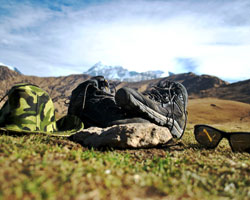


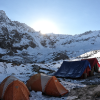






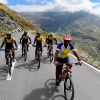
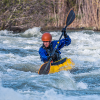
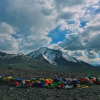

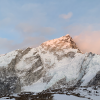
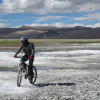
So good to know this background! You guys are doing a great job! Kudos!
Excellent read, very inspiring, looking forward to trek with you this summer.
Thank you, Vaibhav :)
Hey Anil, Thank you!Do let us know which trek are you planning :)